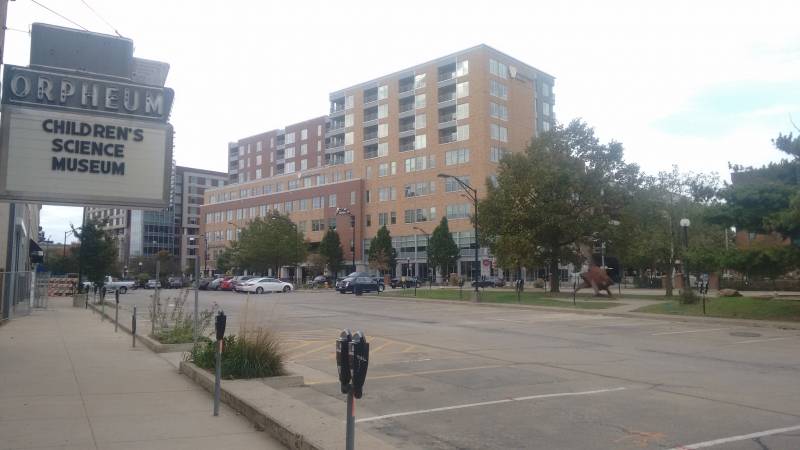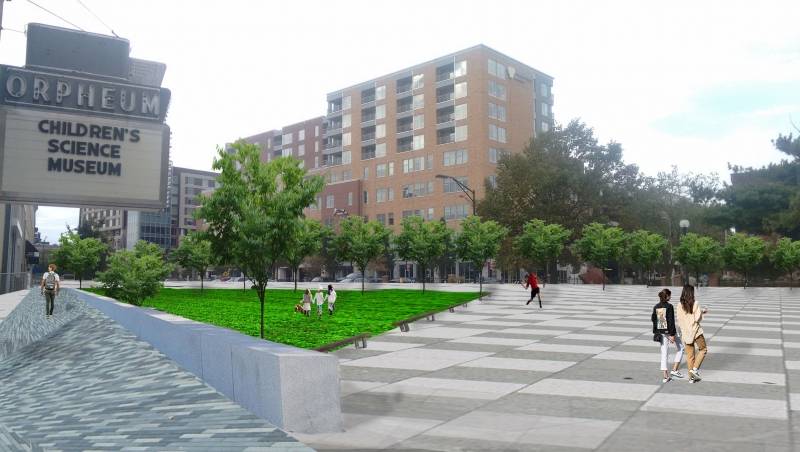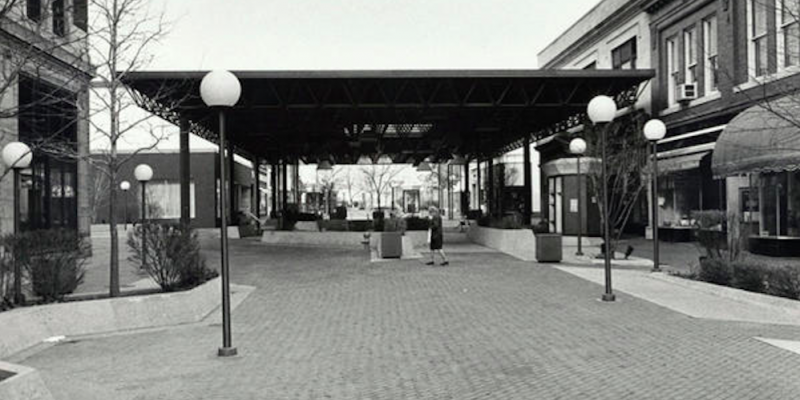With construction fences springing up and massive proposed projects in the pipeline, it seems that Downtown Champaign is finally getting the love it deserves. Though it faces continued competition from the Market Place Shopping Center, Urbana, Campustown, and other business and retail parks in the area, its historic role as a cultural, transportation, and economic hub of Eastern Illinois remains. Everyone I’ve met loves downtown. As Champaign progresses into the 21st century, its downtown core is finally recovering from a half-century of decline and failed urban revitalization. One of those projects was the Champaign Pedestrian Mall.
Pedestrian malls, a 1960’s and ’70’s revitalization scheme employed by big cities like Chicago and Buffalo and smaller cities like Fresno, California, and Atchison, Kansas, were designed to save downtown businesses as they fled en masse to suburban shopping centers by turning downtowns into giant malls; car-free streets, music from the loudspeakers, and public art was all fair game in these new districts. Pedestrian malls were cities’ knee-jerk reactions to the malls of suburbia, white flight, and depopulation in their cores, but these malls effectively stripped the city centers of their authenticity, destroying the magic of hustle and bustle. Regardless, they were the hottest urban planning trend since interstate highways.
From 1975 to 1986 Champaign turned Neil and Taylor Streets into downtown malls, hoping to reverse a then-decades-long trend of steady decline. The city even toyed with the idea of tearing down large portions of their downtown for a Lincoln Square-esque shopping center. Luckily they decided against it. Still, much of the historic downtown made way for parking (this was pushed to the peripheries of the downtown mall to mimic the new-aged mall) as Champaign struggled to keep its downtown alive and conjure some of the allure of a suburban mall. The mall just looked artificial, there was no organic downtown anymore, and once 5pm rolled around and the workers went home, Neil and Taylor Street became desolate corridors. Downtown’s decline continued.
To understand the failure of Champaign’s Downtown Mall, we need to look across the country for the malls that have succeeded, and the ones that failed. A lot of them failed. Aside from destroying the “downtown” feeling, many were not carefully planned, just tossed into the urban fabric. Las Cruces, Fresno, Buffalo, Chicago, Kalamazoo, and Sacramento have all fully or partially reintroduced automobiles into these once-innovative urban spaces. Though a number of factors contributed to the demise of these pedestrian malls, there has been one constant: lack of land uses; these malls were in central business districts, but nobody lived there, nobody went out to the bars after dark, the streets closed down as soon the offices that abutted them did: five PM. These were city streets, they couldn’t shut their doors at designated closing times like suburban shopping malls, so crime ensued during the nighttime hours.
Cities with successful malls like Santa Monica, Boulder, Madison, and Burlington have a few things in common: diverse land use in the immediate area, good links to public transportation, and they are all in close proximity to activity-generating facilities, whether it be a university or tourist attraction. These reclaimed streets are lively and exciting; dotted with street performers and restaurants, these places are the most beloved public spaces in their town.
Today, the pedestrian mall concept has returned on a smaller scale. The City of Champaign has expressed interest in converting the 144-space parking lot at the flatiron-shaped site at Neil and Washington to a public plaza, removing the parking to create 1.6 new acres of public space.

Has Champaign already forgotten the immense failure that was the downtown pedestrian mall? Maybe not, a plaza could work. Here’s why:
For one, no roadways would be closed, just the lot. The Hill Street Parking Deck, other nearby surface parking lots, and possible new street parking could easily substitute the lost spaces without putting people too far from their destinations. It could ignite development in downtown as well. Although Champaign is already riding the wave of downtown development, the plaza could bring some new construction and developments and finally build up downtown Champaign’s northern fringe, spaces where new businesses and residents can improve downtown’s overall vibrancy. The space has all the factors that make for successful public space. The American Planning Association has tied parks to increased property values, increases in municipal revenue, and improvements in overall neighborhood attractiveness. Most importantly, a plaza is an amenity for downtown and the underserved near north side, it could be a place to go for a lunch break, or a space for street performers and festivals, a place to sit, socialize, and people-watch, an improved facility for the farmers’ market, there could even be a playground for the Orpheum included. There’s no final design, so public input is key to shaping what it could be. Maybe it could be the Times Square of Eastern Illinois, would that be “News-Gazette Square?”

When thinking about the pedestrian mall, it is important to note that not all the decline in downtown Champaign was from the pedestrian mall. Rather, it was a prolonged process of demolition and decentralization of services to the retail centers and office parks to the periphery of Champaign-Urbana. Today, there are far more residences, nightlife, and cultural facilities near the potential plaza than there were thirty years ago, these will factor into an overall better space than the pedestrian mall of yore.
For many, parking is a surprisingly sensitive subject. Parking spaces are understandably sacred to residents, people need a place to put their car. But shouldn’t public space also have a position in this hierarchy? Do we want a downtown littered with the dead space of parking lots? Is walking an extra block inconvenient? Most people already walk that distance from parking lots to shopping malls. Maybe shutting down the lot for a week-long trial period would help Champaignites cozy up to the idea. A few lawn chairs and an occasional guitarist may give us a taste of what could be.
There’s no way know just how a plaza will change Champaign, whether it will be for the better or worse, or exactly what it will look like. But it’s worth looking into, researching other cases of pedestrianization, and voicing your ideas and opinions, no matter whether or not you want the plaza.
Be heard! Submit your ideas to the city about this site here. Read back to our Opinion piece about the Plaza Park project.
Images: Smile Politely, own work via Photoshop.








